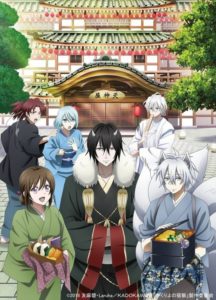![]() The slow march of time through beautiful landscapes and the small moments of existence.
The slow march of time through beautiful landscapes and the small moments of existence.
What They Say:
When Hotaru moves from Tokyo to a tiny town in the rural countryside, she’s in for some serious culture shock: the nearest place that sells comics is 20 minutes away, the nearest video store is ten train stations down the line, and there are only three other girls and one boy in her entire school! Even though everything’s so different, there’s something about the laid-back atmosphere that makes her feel strangely comfortable. While she’ll certainly miss parts of her old life, there’s a whole lifetime of experiences waiting to be enjoyed with her new friends Renge, Komari, Natsumi, and Suguru! In the end, it’s who you’re with, not where you are, that makes a place your home!
The Review:
Audio:
The audio presentation for this release is about what you’d expect in that we get a simple stereo mix with only the Japanese language, which is encoded using the lossless DTS-HD MA codec. The show is all about the ambience and dialogue, so it has to work the calm and quiet scenes well throughout, letting some of the sounds of nature dominate as well as other incidental aspects of it all. It handles it all quite well overall, but like a lot of mixes of this nature it’s not going to come across as striking or impressive, though it does it all in a very good way. There’s some decent placement from time to time with the show as we get a good number of characters together at a time as well as a bit of depth as well, though less of that overall. Dialogue is clean and clear throughout and we didn’t have any problems with dropouts or distortions during regular playback.
Video:
Originally airing in 2013 and 2015, the transfer for this twenty-four episode series that ran in two seasons is presented in its original aspect ratio of 1.78:1 in 1080p using the AVC codec. The twelve episodes for each cour are spread across two discs with nine on the first and three on the second. Animated by Silver Link once again, the show has another round of beautiful backgrounds that just brings the settings to life here in a great way. The series has a lot of static backgrounds throughout it which makes it easier to work with a mid-rage bit rate that lands mostly around the twenty range with plenty of variation near it. That’s definitely welcome as there’s a lot of great colors here that stand out well and add to the overall richness of the show that definitely needs to be seen in high definition. Though it’s not the most animated of series, it does handle its animation well but it also balances it out with some good details to the characters, beautiful colors in backgrounds and foregrounds and fluidity of animation when necessary. This is a really well done show in that it immerses you in the area through the visuals and the transfer captures that.
Packaging:
The packaging for this release is done up with a thicker than normal case to hold the four Blu-ray discs with hinges. The front cover gives us the main cast of characters together having fun in the snow with cute snow bunnies and snowmen that has a light and charming air about it all. The logo is bright and colorful but it can be difficult to tell what this is since it could feel like a re-release of the first season until you note the strip along the bottom with the episode count. It just feels like it needed a better title for the collection. The back cover works in the natural colors nicely with more background material along the top under the tagline while the bottom goes for a solid shade of orange for the production information and the technical grid. The top strip has some good character artwork and a solid slate of shots from the show that shows off more of the various locations while the premise, done in red text on white, covers things really well in exploring the basics of the cover. No show related inserts are included nor is there a reversible cover.
Extras:
The extras for this release definitely step things up several notches and for some fans will ease the lack of a dub. While the first season has just the clean opening and closing, the second season goes for more. The big extra is that we get multiple of the Japanese commentary tracks, which are hellish pieces to translate and Sentai gets huge props for handling that for the fans. The release also comes with a fun cast panel video that runs about fifteen minutes, a round or promos, and the clean opening and closing sequence. We also get over an hour across six installments of the Dagashi videos. These are fun little cast talk pieces done for each of the Japanese volumes where they spend some time in a candy store having fun and then the actresses sit around in a room talking about a range of things related to the show and their characters. They’re best parceled out in small doses simply because there’s so much of it.
Content: (please note that content portions of a review may contain spoilers)
Based on the manga of the same name by Atto, Non Non Biyori is a twelve episode series animated by Silver Link which was broadcast during the fall of 2013 that was followed-up in 2015 with the Non Non Biyori Repeat season. The original manga began back in 2009 and has eleven volumes to its name so far, giving this a fair bit of material to work with overall. Slice of life shows are ones that can be worked a bit easier anyway since they have a natural slowness to them that can lead to some creative and fun ways of stretching things out a bit. With this series, we get taken out of the usual norm for a show like this in that it puts us in the countryside village of Asahigaoka. Having spent my own time in far off places that are quite similar to this, you can definitely feel a certain truth coming from the design of a series like this.
While we’ve had countryside village stories before, often they take us to more regional schools where we get a fairly normal kind of crowd that has the standard size to it but without the whole big city aspect. What they do here instead is introduce to us the place through the arrival of Hotaru, a fifth year elementary student who has come from Tokyo due to a job transfer her father had. She’s not a worldly Tokyoite or anything but simply comes across as a normal kid. One that’s shocked to find that her new school has four students in it prior to her arriving. The school takes place in a single classroom that’s handled by a single teacher, Kazuho, who herself graduated from here several years ago. It’s more a traditional Little House on the Prairie kind of school where we get everything that’s taught at the same time in a way but it’s more about self study and working through workbooks rather than Kazuho actually teaching. Which is good since she’s more predisposed to sleeping most of the time like a cat.
The make-up of the class is heavily tilted towards the girls as there are three of them versus the single boy and the arrival of Hotaru makes it all the more tilted. The single boy is the elder brother of Natsume and Komari, which gives us three of the characters being siblings in the class of four, which is awkward enough. To make it more so, the first grade student in here, Renge, is related to Kazuho, so there’s a lot of easy familiarity among everyone because of this situation. Hotaru’s arrival is one that doesn’t exactly upset it since the girls all get together more and just hang out, especially since Suguru as the only male is barely used and barely even qualifies as window dressing since he has a handful of lines at best here. Which works well enough since this is pretty much an all-girls show anyway, but at least that make mention of one or two boys along the way so that it’s not as if boys don’t exist at all.
Thankfully, the show doesn’t focus on Hotaru as the view of the village from a big city girl, though we get some of it to start. It works well enough to introduce us to the village and some of the quirks of it, but it’s largely a normal place where you have to travel to a nearby city for a normal market and other kinds of amenities. There’s a few simple places within the village, but the only noteworthy one that really comes up is that there’s a candy shop that’s run by a former alumni of the school who is barely eking out an existence since there aren’t a lot of people here and little in the way of money. A lot of the show simply takes place at the school, but it also doesn’t spend all of its time there as it shifts around other areas that really does a good job to accent its beauty. There’s an episode that focuses nicely on this as we get Renge meeting a girl who has come to visit her grandmother for the summer and she shows her around so she can take lots of pictures. It’s a nice story in that it gives Renge someone her own age to interact with, though you know it won’t last.
The draw of a show like this is the slow moments themselves, the way they interact with each other and just hang out. Because of the big age differences at times with them, and some of the silliness of the height differences as well since second year middle school student Komari is shorter than her younger sister, and almost on a first grade level at about four foot nine, you get plenty of situations come up that deals with these differences. During the simple and mostly non-fanservice oriented beach segment, Komari goes off to get drinks for everyone but a few of the caretakers in the area worry that she’s a lost little girl and keep her with them until her friends come and pick her up. Everyone is apologetic, but there is definitely some comedy to be had with these even as you feel bad for Komari. Though you can’t help but to enjoy the way Renge even gets a few good laughs in with it.
Non Non Biyori works through plenty of familiar stories as it goes on, from a rather cute late night challenge of bravery that panics the girls to a more personal piece where Komari and Natsume deal with Komari watching a ghost movie that freaks her out more than she thought it would. Of course, siblings make everything worse and Natsume really torments her in a big way. Cooking figures into the show as well of course and there’s also a good episode where they try to put on a culture festival with a cafe while drawing in a few other alumni in order to make it profitable. Not that anyone in the class can even read a recipe and follow it – Kazuho included – which makes it a comical bit to watch. Still, having some of the older students come back makes it fun to watch since there’s some family relations in there as well. You can see the echos of that generation coming through upon revisiting.
Silver Link’s work on the show here is important because the quality of the animation in terms of design really is critical. It may be a bit more green natural than some might expect in a way, but it has a big naturalistic look to it and a bit too clean, but it paints an appealing picture of saying that there is much to like out here and that there are many happy people in that area. The background designs are just beautiful throughout when it comes to the outdoors and they do just as solid inside, though that’s a bit more traditional. Similarly, the character designs have a lot of appeal as there are some real differences in the characters but they each have their quirks that make them stand out. It’s not a series with high fluid animation because it’s simply not necessary as it’s all dialogue driven with simple movements, but what they do offer really comes across well and leaves you with a very good impression of the project as a whole.

























